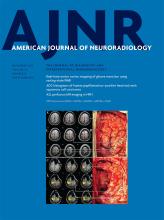Index by author
Dessouky, R.
- Peripheral Nervous SystemYou have accessMR Neurography of Greater Occipital Nerve Neuropathy: Initial Experience in Patients with MigraineL. Hwang, R. Dessouky, Y. Xi, B. Amirlak and A. ChhabraAmerican Journal of Neuroradiology November 2017, 38 (11) 2203-2209; DOI: https://doi.org/10.3174/ajnr.A5354
Detmer, F.
- EDITOR'S CHOICENeurointerventionOpen AccessAngioarchitectures and Hemodynamic Characteristics of Posterior Communicating Artery Aneurysms and Their Association with Rupture StatusB.J. Chung, R. Doddasomayajula, F. Mut, F. Detmer, M.B. Pritz, F. Hamzei-Sichani, W. Brinjikji, D.F. Kallmes, C.M. Jimenez, C.M. Putman and J.R. CebralAmerican Journal of Neuroradiology November 2017, 38 (11) 2111-2118; DOI: https://doi.org/10.3174/ajnr.A5358
The authors studied 313 posterior communicating artery aneurysms (145 ruptured, 168 unruptured) with image-based computational fluid dynamics. Aneurysms were classified into different angioarchitecture types depending on the location of the aneurysm with respect to parent artery bifurcation. Ruptured aneurysms had higher, more concentrated, and more oscillatory wall shear stress distributions; stronger and more concentrated inflow jets; and more complex and unstable flow patterns compared with unruptured aneurysms. They conclude that high-flow intrasaccular hemodynamic characteristics, commonly found in bifurcation-type angioarchitectures, are associated with the posterior communicating artery aneurysm rupture status.
Deveber, G.A.
- Pediatric NeuroimagingOpen AccessClinical and Imaging Characteristics of Arteriopathy Subtypes in Children with Arterial Ischemic Stroke: Results of the VIPS StudyM. Wintermark, N.K. Hills, G.A. DeVeber, A.J. Barkovich, T.J. Bernard, N.R. Friedman, M.T. Mackay, A. Kirton, G. Zhu, C. Leiva-Salinas, Q. Hou, H.J. Fullerton and the VIPS InvestigatorsAmerican Journal of Neuroradiology November 2017, 38 (11) 2172-2179; DOI: https://doi.org/10.3174/ajnr.A5376
Do, H.M.
- NeurointerventionYou have accessPatient Outcomes and Cerebral Infarction after Ruptured Anterior Communicating Artery Aneurysm TreatmentJ.J. Heit, R.L. Ball, N.A. Telischak, H.M. Do, R.L. Dodd, G.K. Steinberg, S.D. Chang, M. Wintermark and M.P. MarksAmerican Journal of Neuroradiology November 2017, 38 (11) 2119-2125; DOI: https://doi.org/10.3174/ajnr.A5355
Dodd, R.L.
- NeurointerventionYou have accessPatient Outcomes and Cerebral Infarction after Ruptured Anterior Communicating Artery Aneurysm TreatmentJ.J. Heit, R.L. Ball, N.A. Telischak, H.M. Do, R.L. Dodd, G.K. Steinberg, S.D. Chang, M. Wintermark and M.P. MarksAmerican Journal of Neuroradiology November 2017, 38 (11) 2119-2125; DOI: https://doi.org/10.3174/ajnr.A5355
Doddasomayajula, R.
- EDITOR'S CHOICENeurointerventionOpen AccessAngioarchitectures and Hemodynamic Characteristics of Posterior Communicating Artery Aneurysms and Their Association with Rupture StatusB.J. Chung, R. Doddasomayajula, F. Mut, F. Detmer, M.B. Pritz, F. Hamzei-Sichani, W. Brinjikji, D.F. Kallmes, C.M. Jimenez, C.M. Putman and J.R. CebralAmerican Journal of Neuroradiology November 2017, 38 (11) 2111-2118; DOI: https://doi.org/10.3174/ajnr.A5358
The authors studied 313 posterior communicating artery aneurysms (145 ruptured, 168 unruptured) with image-based computational fluid dynamics. Aneurysms were classified into different angioarchitecture types depending on the location of the aneurysm with respect to parent artery bifurcation. Ruptured aneurysms had higher, more concentrated, and more oscillatory wall shear stress distributions; stronger and more concentrated inflow jets; and more complex and unstable flow patterns compared with unruptured aneurysms. They conclude that high-flow intrasaccular hemodynamic characteristics, commonly found in bifurcation-type angioarchitectures, are associated with the posterior communicating artery aneurysm rupture status.
Domingo Ayllon, M.
- FELLOWS' JOURNAL CLUBHead and Neck ImagingOpen AccessApparent Diffusion Coefficient Histograms of Human Papillomavirus–Positive and Human Papillomavirus–Negative Head and Neck Squamous Cell Carcinoma: Assessment of Tumor Heterogeneity and Comparison with HistopathologyT. de Perrot, V. Lenoir, M. Domingo Ayllón, N. Dulguerov, M. Pusztaszeri and M. BeckerAmerican Journal of Neuroradiology November 2017, 38 (11) 2153-2160; DOI: https://doi.org/10.3174/ajnr.A5370
One hundred five consecutive patients with primary oropharyngeal and oral cavity head and neck squamous cell carcinoma underwent MR imaging with anatomic and DWI sequences. The collected tumor voxels from the contoured ROIs provided histograms from which position, dispersion, and form parameters were computed. Histogram data were correlated with histopathology, p16-immunohistochemistry, and polymerase chain reaction for human papillomavirus DNA. Diffusion phenotypes of human papillomavirus–positive and human papillomavirus–negative head and neck squamous cell carcinomas showed significant differences, which reflect their distinct degree of tumor heterogeneity.
Dremmen, M.H.G.
- Pediatric NeuroimagingYou have accessDoes the Addition of a “Black Bone” Sequence to a Fast Multisequence Trauma MR Protocol Allow MRI to Replace CT after Traumatic Brain Injury in Children?M.H.G. Dremmen, M.W. Wagner, T. Bosemani, A. Tekes, D. Agostino, E. Day, B.P. Soares and T.A.G.M. HuismanAmerican Journal of Neuroradiology November 2017, 38 (11) 2187-2192; DOI: https://doi.org/10.3174/ajnr.A5405
Dulguerov, N.
- FELLOWS' JOURNAL CLUBHead and Neck ImagingOpen AccessApparent Diffusion Coefficient Histograms of Human Papillomavirus–Positive and Human Papillomavirus–Negative Head and Neck Squamous Cell Carcinoma: Assessment of Tumor Heterogeneity and Comparison with HistopathologyT. de Perrot, V. Lenoir, M. Domingo Ayllón, N. Dulguerov, M. Pusztaszeri and M. BeckerAmerican Journal of Neuroradiology November 2017, 38 (11) 2153-2160; DOI: https://doi.org/10.3174/ajnr.A5370
One hundred five consecutive patients with primary oropharyngeal and oral cavity head and neck squamous cell carcinoma underwent MR imaging with anatomic and DWI sequences. The collected tumor voxels from the contoured ROIs provided histograms from which position, dispersion, and form parameters were computed. Histogram data were correlated with histopathology, p16-immunohistochemistry, and polymerase chain reaction for human papillomavirus DNA. Diffusion phenotypes of human papillomavirus–positive and human papillomavirus–negative head and neck squamous cell carcinomas showed significant differences, which reflect their distinct degree of tumor heterogeneity.
Eilaghi, A.
- Adult BrainYou have accessDetection of Volume-Changing Metastatic Brain Tumors on Longitudinal MRI Using a Semiautomated Algorithm Based on the Jacobian Operator FieldO. Shearkhani, A. Khademi, A. Eilaghi, S.-P. Hojjat, S.P. Symons, C. Heyn, M. Machnowska, A. Chan, A. Sahgal and P.J. MaralaniAmerican Journal of Neuroradiology November 2017, 38 (11) 2059-2066; DOI: https://doi.org/10.3174/ajnr.A5352








